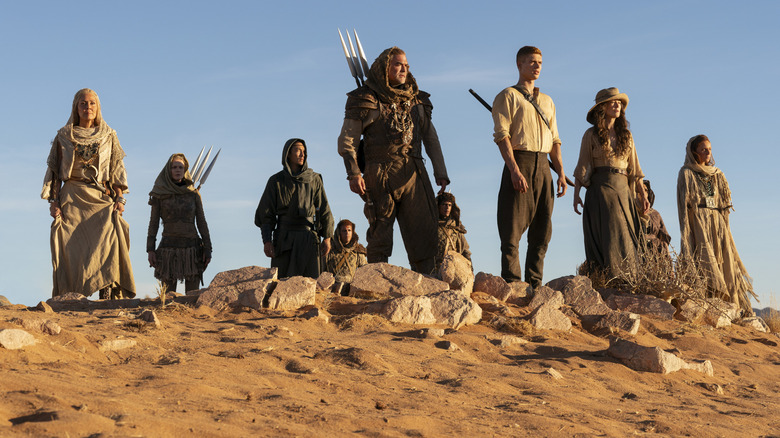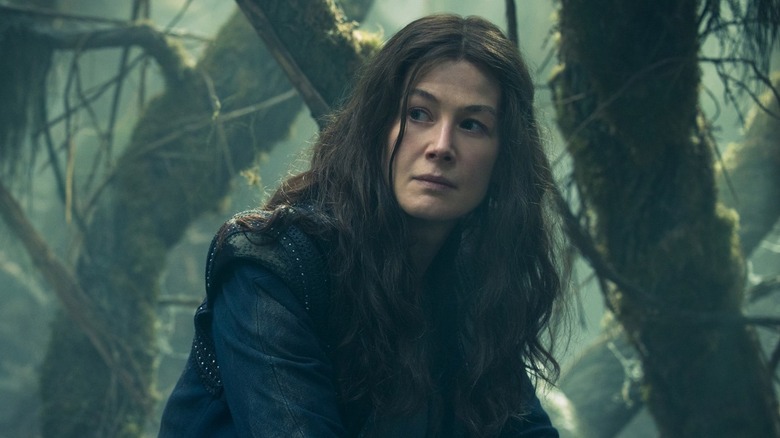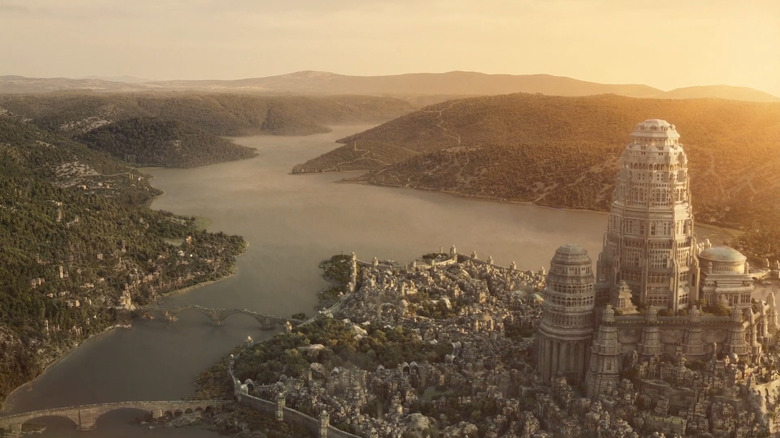Why Prime Video Canceled Wheel Of Time After Three Seasons
Prime Video's "Wheel of Time" series is officially over. Even as the show was still basking in the glow of a triumphant third season that was hailed by many as a cinematic achievement worthy of any fantasy story, it has now abruptly (though not unexpectedly) come to a halt.
As for so many other members of the "Wheel of Time" passionate fan base, this is tragic news for this poor writer. It's a production that is near and dear to my heart. Along with being a fan of the original book series, I was invited to visit Jordan Studios in Prague a couple of years back. I saw dozens of the over 300 sets the studio built for the show (many of which are contained in a massive 350,000 square-foot reclaimed Soviet-era trucking facility). I interviewed producers, cast, and crew, saw choreography sequences practiced in real time, and even watched the first two episodes of season 2 right in the warm comfort of the Winespring Inn with popcorn and a fine flagon of Two Rivers ale in hand. (No joke.)
Trust me when I say I've seen the scale, commitment, and love invested in this production. I've watched it grow in popularity even as it scaled its story and managed to adapt an utterly overwhelming amount of source material into a genuinely interesting and compelling (albeit severely truncated) serialized adaptation.
So, what went wrong, then? What is it that tanked this seemingly healthy, popular project that appeared to have a future brighter than the One Power itself? In a word: Money.
Why was Wheel of Time canceled after season 3?
If you're wondering what killed the impressive Robert Jordan adaptation, it was the almighty dollar. According to Deadline, which broke the news of the show's cancellation, the decision not to renew the show for a fourth season came after lengthy deliberations. The publication added:
As often is the case in the current economic environment, the reasons were financial as the series is liked creatively by the streamer's executives.
The "current economic environment" detail stands out. The implication that if the show had aired in better times, it would still be on track for season 4 stings. The saddest part, though, is that last bit: Even the Prime Video execs who made the hard decision liked this thing — and they weren't alone. It was pretty impressive, and audiences knew it. The ratings were at all-time highs when the show was canceled. The Wheel of Time Rotten Tomatoes audience score jumped from 38% to 60% between season 1 and season 2. Season 3 got darker, picked up the pace, and reached even loftier heights, with an 83% audience score as of this writing. Critic scores were generally kinder all along, but still stood at an extremely impressive 97% for season 3.
Nevertheless, the lifeblood of a show (actual viewership) has dwindled over the course of the three-season run. According to Deadline, The Wheel of Time season 1 was Prime Video's most-watched series premiere of 2021 and a Top 5 all-time launch at the time. While viewership has remained relatively strong, especially globally, it has not been enough. The show didn't even reach Nielsen's Top 10 Originals chart throughout the first three weeks of season 3. Fortunately, the creators were smart enough to see the writing on the wall and crafted the season 3 finale with at least a degree of closure (as much as is possible in Jordan's mammoth, interwoven story).
The cost of the Wheel of Time makes sense
For myself, the cancellation was always a possibility after I visited the set. If this isn't clear by now, this wasn't because the show was bad. On the contrary, it was remarkably well done and featured a great cast. Critically, it also accomplished what I consider to be a rare feat in modern media: It consolidated a mountain of source material (14 huge books from the original Robert Jordan series) into something resembling a cohesive and compelling story.
No, it wasn't the production itself that had me thinking the show was destined for the chopping block. It was the sheer cost associated with the production. As is typical with Prime Video's tentpole series, the studio poured a ton of money into everything, from VFX to sets, cinematography, and every other element. While on set, I saw dozens of hair pieces and elaborate costumes. They had to use a golf cart to move people around for interviews, not just for convenience but because it was legitimately far to walk from one set to the next.
The Tar Valon set was particularly impressive. It had a real, gigantic gate, was at least two stories high in most areas, and went out of sight. Side roads were real, and all of the props were legitimate. I remember picking up the smallest piece of a peddler's pack and observing its handmade intricacies. Cool? Absolutely. (The nerd in me was geeking out the whole time.) Expensive, though? You bet your bottom dollar. If anything doomed this production from the start, it was the over-the-top investment in making a genuinely awe-inspiring show that impressed from the smallest costume detail to the largest otherworldly set.
It's a shame that "Wheel of Time" is destined for the dustbin of Hollywood. But make no mistake, even if a heavy balance sheet in a bad economy was what did this one in, it leaves behind three seasons of the best filmed fantasy adaptation money can buy.


